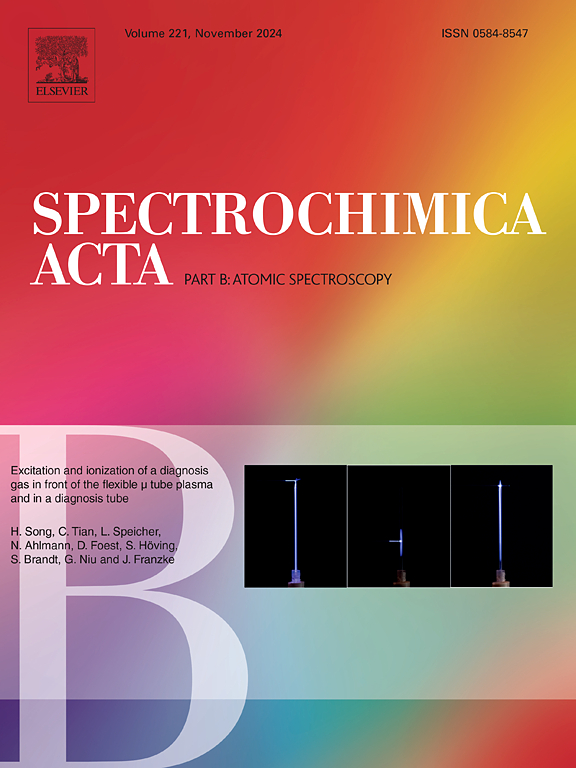A study on the accurate classification of complex coal samples using Raman-XRF combined spectroscopy
IF 3.8
2区 化学
Q1 SPECTROSCOPY
引用次数: 0
Abstract
Coal is one of the most important energy resources globally, and its classification and analysis are crucial for improving utilization efficiency, optimizing process design, and achieving cleaner usage. However, due to the complex composition of coal and significant differences in its physicochemical properties, traditional single-spectral detection techniques often struggle to simultaneously consider the information on organic molecular structures and inorganic components in coal sample classification, resulting in limited classification accuracy. To address this issue, this study proposed a combined detection technique based on Raman spectroscopy and X-ray fluorescence (XRF) spectroscopy, integrated with machine learning algorithms, to achieve precise classification of complex coal samples. Raman spectroscopy provided high sensitivity to the organic components of coal samples, focusing on molecular structures and aromatic group characteristics, while XRF spectroscopy revealed inorganic components through its rapid quantitative capabilities for multiple elements. The combination of these two types of spectra achieved a complementarity of organic and inorganic information, effectively enhancing the accuracy and stability of the classification. This study first conducted standard deviation (SD) and coefficient of variation (CV)analyses on the collected Raman and XRF spectral data to assess their stability. The results indicated that the Raman and XRF spectral data sets possessed good stability, providing a solid foundation for the classification study. Subsequently, various machine learning algorithms, including Support Vector Classifier (SVC) and Random Forest (RF), were employed for coal sample classification, with model parameters optimized through cross-validation grid search. The research demonstrated that the SVC model based on Raman-XRF fusion data significantly improved classification accuracy compared to single-spectral techniques, with increases of 5.95 % (Raman) and 4.76 % (XRF), thereby validating the advantages of Raman spectroscopy in detecting organic molecular structures and the efficient complementarity of XRF spectroscopy in chemical element analysis. This study not only enhances the classification accuracy of complex coal samples but also provides theoretical and technical support for online real-time detection of coal in complex environments within the coal industry.

拉曼- xrf联合光谱对复杂煤样精确分类的研究
煤炭是全球最重要的能源资源之一,煤炭分类分析对提高利用效率、优化工艺设计、实现清洁利用具有重要意义。然而,由于煤的组成复杂,其物理化学性质差异较大,传统的单光谱检测技术在煤样品分类中往往难以同时考虑有机分子结构和无机成分的信息,导致分类精度有限。针对这一问题,本研究提出了一种基于拉曼光谱和x射线荧光(XRF)光谱的组合检测技术,结合机器学习算法,实现复杂煤样的精确分类。拉曼光谱对煤样品的有机成分具有高灵敏度,重点关注分子结构和芳香族特征,而XRF光谱通过其对多种元素的快速定量能力来揭示无机成分。这两类光谱的结合实现了有机和无机信息的互补,有效提高了分类的准确性和稳定性。本研究首先对收集的拉曼光谱和XRF光谱数据进行标准差(SD)和变异系数(CV)分析,以评估其稳定性。结果表明,拉曼光谱和XRF光谱数据集具有良好的稳定性,为分类研究提供了坚实的基础。随后,采用支持向量分类器(SVC)和随机森林(RF)等多种机器学习算法对煤样进行分类,并通过交叉验证网格搜索优化模型参数。研究表明,基于拉曼-XRF融合数据的SVC模型与单光谱技术相比,分类精度显著提高,分别提高了5.95%(拉曼)和4.76% (XRF),从而验证了拉曼光谱在检测有机分子结构方面的优势,以及XRF光谱在化学元素分析中的高效互补。本研究不仅提高了复杂煤样的分类精度,而且为煤炭行业复杂环境下的煤炭在线实时检测提供了理论和技术支持。
本文章由计算机程序翻译,如有差异,请以英文原文为准。
求助全文
约1分钟内获得全文
求助全文
来源期刊
CiteScore
6.10
自引率
12.10%
发文量
173
审稿时长
81 days
期刊介绍:
Spectrochimica Acta Part B: Atomic Spectroscopy, is intended for the rapid publication of both original work and reviews in the following fields:
Atomic Emission (AES), Atomic Absorption (AAS) and Atomic Fluorescence (AFS) spectroscopy;
Mass Spectrometry (MS) for inorganic analysis covering Spark Source (SS-MS), Inductively Coupled Plasma (ICP-MS), Glow Discharge (GD-MS), and Secondary Ion Mass Spectrometry (SIMS).
Laser induced atomic spectroscopy for inorganic analysis, including non-linear optical laser spectroscopy, covering Laser Enhanced Ionization (LEI), Laser Induced Fluorescence (LIF), Resonance Ionization Spectroscopy (RIS) and Resonance Ionization Mass Spectrometry (RIMS); Laser Induced Breakdown Spectroscopy (LIBS); Cavity Ringdown Spectroscopy (CRDS), Laser Ablation Inductively Coupled Plasma Atomic Emission Spectroscopy (LA-ICP-AES) and Laser Ablation Inductively Coupled Plasma Mass Spectrometry (LA-ICP-MS).
X-ray spectrometry, X-ray Optics and Microanalysis, including X-ray fluorescence spectrometry (XRF) and related techniques, in particular Total-reflection X-ray Fluorescence Spectrometry (TXRF), and Synchrotron Radiation-excited Total reflection XRF (SR-TXRF).
Manuscripts dealing with (i) fundamentals, (ii) methodology development, (iii)instrumentation, and (iv) applications, can be submitted for publication.

 求助内容:
求助内容: 应助结果提醒方式:
应助结果提醒方式:


